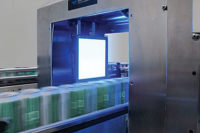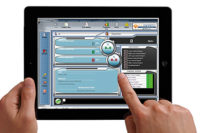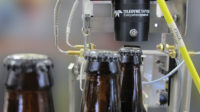On the production line, beverage packages face multiple obstacles, such as chipped or broken glass, deformed plastic, mis-seamed cans, over- or under-filling, incorrect labeling, leaking, contamination, and misapplied caps and closures, to name a few defects. Despite these challenges, beverage packages are expected to represent a safe, quality product on the shelf.
“Today’s consumers are highly sensitive to quality issues,” says Mike Lawn, technical director for BBULL USA Inc., Oldsmar, Fla. “A single bad experience with your product may result in a decline in sales, especially if the media or social networking [sites] get involved. Poor presentation on the shelf may send the customer to your competition. In some markets, returns and re-select can have a major financial implication to the business.”
Although manual inspectors can do a great job at detecting defects, studies show that concentration levels can only be sustained for very limited periods of time, Lawn says. And on high-speed lines, automated inspection equipment is essential, he adds.
Lights, camera, action!
Monitoring Technology LLC, Fairfax, Va., offers high-speed cameras under the 20/20 Hindsight brand name that record video at a higher speed than the human eye can detect, enabling operators to view a jam in slow motion and solve the issue quickly, says Russell Leonard, Hindsight product manager. Unlike the older generation of high-speed cameras, which only stored a few seconds of record time, Hindsight offers systems that record as many as 120 hours, he says. The cameras also allow beverage-makers to achieve better line efficiency, reduce off-quality product and avoid costly breakdowns, he says.
“Given that many issues occur sporadically and at very high speeds, it can be nearly impossible for the human eye to catch a jam at the right time,” Leonard explains. “The Hindsight camera continually records up to 10,000 images per second, so operations and maintenance personnel can replay events in ultra-slow motion. Often, seeing the jam or issue in slow motion will show how to keep it from reoccurring in the future.”
FT System North America offers IE700 camera-based label inspection products for beverage segments where appearance is critical or unit cost is high, says Rick Reardon, manager for the Suwanee, Ga.-based company. The IE700 systems use one to four cameras, depending on the application, and are capable of detecting label and coding defects. A more recent addition to the IE700 series vision systems are five-megapixel cameras, which allow the system to inspect a larger area with the same high resolution and translation as well as better performance with less hardware, he says.
Proactive detection
In the ready-to-drink, aseptic, dairy and carbonated beverage categories, the FT System TB1000 and TB5000 leak inspection systems are popular for their ability to detect fill-level defects and very small leaks in plastic or aluminum containers at full production speeds, Reardon says. The company’s CL700 line of fill-level and closure inspection systems also is popular because it not only detects a defective container, but also can pinpoint the cause of the defect when equipped with the appropriate monitoring system, he says.
“Just finding a defect doesn’t cut it anymore,” Reardon explains. “Beverage-makers need to know what caused the defect and how they can prevent it from happening again.”
Furthermore, they need to anticipate an issue before it has a chance to impact production or quality, he says. As a result, FT System offers monitoring systems with all of its fill-level and closure inspection equipment that can alert line operators when a specific fill valve or capper head is trending out of specification.
Data obtained regularly from CMC-Kuhnke Inc.’s can seaming inspection software reveals trends that can determine if machinery parts are wearing or getting off registration, and adjustments and maintenance can be scheduled accordingly to prevent issues down the line, says John Wagg, sales and operations manager for the Albany, N.Y.-based company.
BBULL USA’s Cankon system was designed specifically to increase production efficiencies on high-speed canning lines by detecting and removing damaged cans before they are filled to prevent potential jams in the filler or sealer, Lawn says. The BBULL Stratecs filler monitoring systems also aim to increase efficiency by identifying issues with the filler’s components, allowing quick access for maintenance staff. Additionally, burst bottle detection can clear potentially contaminated product with no downtime, and the VTD module stops the line when a filler tube is displaced, he adds.
Although detecting defective packaging can be challenging, removing a container from the line without causing production jams, damaging the package or spilling product is even more difficult, Lawn says. Nevertheless, the company offers guaranteed performance on most container types and styles with its BBULL Centro soft-ejection and distribution systems. It also released its new BBULL Snake system, which was designed to replace the “slat”-based Synchron unit with improved handling and reliability, he says.
New and noteworthy
Considering the difficulty in rejecting a package from the line, oftentimes preventing the problem is more cost-effective than removing rejected products, says Tim Kelley, vice president of marketing for Tri-Tronics Co., Tampa, Fla.
Tri-Tronics offers a selection of sensors used for beverage inspection. In conjunction with its product inspection controller PIC-1 power supply, its Smarteye, RetroSmart, Stealth UV, ColorWise, XP10 X-Pro and other sensors are used for their high-speed accurate detection capabilities, ease of use and other benefits, Kelley says. Recently, the company released an Ultrasonic Clear Label sensor with a fully visible organic light emitting diode (OLED) display where operators can view signal strength, repeat performance contrast numbers, quick set-up instructions, timers and a sensor scope. The Ultrasonic Clear Label sensor is capable of detecting labels on a web for applying or counting the labels, as well as detecting web breaking, web splicing and edge guiding, he says.
This year, Tri-Tronics acquired Photocraft Encoders, a complementary, synergistic product line that enables the company to offer even more inspection solutions, Kelley says.
When it comes to leak inspection, Teledyne TapTone, a business unit of Teledyne Instruments Inc., offers a line of patented technologies, says Melissa Rossi, marketing manager for the North Falmouth, Mass.-based company. The TapTone Acoustic System, an industry standard, uses an electro-magnetic pulse against metal crowns on beer bottles to detect leakage. However, the mainstay of the business now is leak inspection of flexible containers, such as plastic bottles, she says.
Teledyne TapTone’s vision inspection is becoming more popular due to its versatility, Rossi notes. Last year, the company launched a new vision inspection system called TotalVu. This year, it released a new top-down pressure sensor for specialty containers that have foil or plastic seals on the lids, such as a yogurt, she explains. The new leak inspection sensor for containers sealed with foil or plastic is much more sensitive than the side-pressure system, she adds.
For double-seam cans, CMC-Kuhnke offers its popular SeamScan SPC system, which now features a high-resolution color camera, Wagg says. One of the company’s more recent innovations is the SeamScan XTS X-Ray Tightness Scanner. Using the same process as the SeamScan SPC system, the new X-ray scanner is a non-destructive tool for operator-independent double-seam tightness measurement, Wagg explains.
“Designed specifically for can-makers and brand owners, SeamScan XTS delivers a high-resolution X-ray seam scope and a powerful automatic wrinkle inspection system in a compact and user-friendly system,” he says. “The XTS can save can-makers and brand owners hundreds of thousands of dollars each year simply by reducing product spoilage caused by traditional destructive double-seam inspection methods.”
Forecasting future trends
The SeamScan XTS is an example of the trend in inspection equipment toward non-destructive measurement, Wagg says. He also notes a trend toward automation, such as CMC-Kuhnke’s Mars-XTS product, the fully automated version of its SeamScan XTS. The Mars-XTS can be installed in-line and will automatically pull the specified number of cans each hour as required by the company’s quality control needs, he says.
“We believe automated, non-destructive testing will become the standard method for double-seam inspections within the next 10 to 15 years,” Wagg says.
Adaptability to various container weights, shapes and sizes is another trend in the industry, according to suppliers.
“In the future, I would say the trend in packaging is to lighter weighted, more flexible containers,” says Teledyne TapTone’s Rossi. “I think those are always a challenge from an inspection standpoint, so I see equipment being geared toward that type of container.”
Responding to the trend toward more unique packaging, BBULL USA offers the Stratecs Container Orientation System interfaced into a servo-controlled labeler for label placement on bottles with complex designs, Lawn says. He also notes that many high-speed fillers have been working toward the goal of 100 percent full bottle inspection as well as moving inspection equipment further down the line and away from core equipment.
“Until recently, label inspection on round containers has only been practical in the labeler,” Lawn explains. “The BBULL Image 360 uses the latest gaming technology to virtually unwrap and re-orientate the container electronically. This allows us to locate label inspection outside of the labeler in a dedicated unit.”
Suppliers also predict that as inspection equipment evolves, it will become more intuitive for operators. For instance, Monitoring Technology offers a high-speed 2020Cam system that is Internet-ready with wired and wireless connectivity, Leonard says. This allows the camera to be used on a bottling line in Munich, and the machine manufacturer in Ohio can connect and use the system in real time, for example.
Tri-Tronics’ Kelley also notes an all-in-one approach to inspection equipment, such as a vision sensor that includes the controller to drive the hardware; smartphone or tablet apps that make setup easier and more available, reducing the need for expensive application and integration expertise; and dedicating a website to discussion about inspection techniques and best practices, he says. BI








